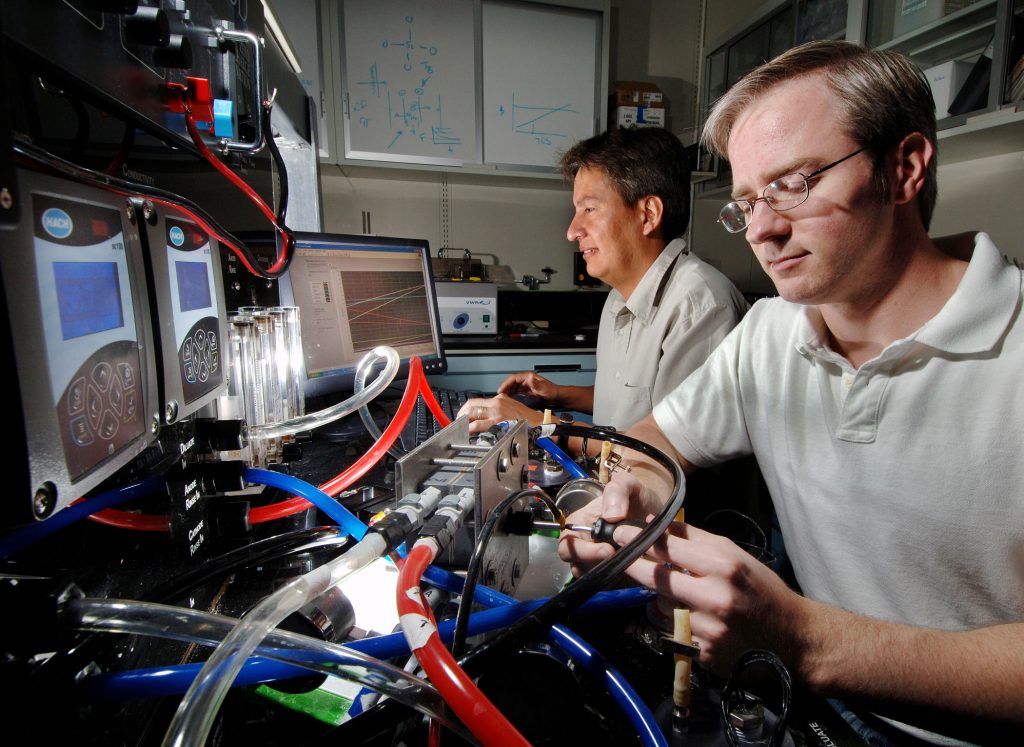
ALBUQUERQUE, N.M. — After one last meeting in San Antonio in April, Sandia National Laboratories researchers Pat Brady and Tom Hinkebein are putting the final touches on the updated Desalination and Water Purification Roadmap — “Roadmap 2” — that should result in more fresh water in parts of the world where potable water is scarce.
The updated roadmap is the result of three previous meetings — two in San Diego and one in Tampa — and the last held in April where many government agency, national laboratory, university, and private partners gathered to map out the future of desalination in the U.S. The first roadmap identified overall goals and areas of desalination research and was submitted to Congress in 2003.
Brady expects the second roadmap to be completed shortly, and the Joint Water Reuse & Desalination Task Force will then submit it to Sen. Pete Domenici, R-N.M., chairman of the Senate Energy and Water Development Appropriations Subcommittee, Congress and eventually the water user and research communities. The task force consists of the Bureau of Reclamation, the WaterReuse Foundation, the American Water Works Association Research Foundation, and Sandia.
The roadmap will recommend specific areas of potential water desalination research and development that may lead to technological solutions to water shortage problems.
“Population growth in the U.S. is expected to increase 13.6 percent per decade [over the next two decades],” says Hinkebein, manager of Sandia’s Geochemistry Department and head of Sandia’s Advanced Concepts Desalination Group. “There will be 29 percent more of us in 20 years. Put that together with an unequal distribution of people — more moving to Texas, California, Arizona, and New Mexico where fresh water is limited — and it is easy to see we are facing a challenging water future.”
Sandia is a National Nuclear Security Administration laboratory.
Only 0.5 percent of Earth’s water is directly suitable for human consumption. The rest is composed of saltwater or locked up in glaciers and icecaps. As the world’s population grows, the increased water demand will have to come from someplace. Brackish water seems to be a natural source, Hinkebein says.
Roadmap 2 will outline the specific research needed in high-impact areas to create more fresh water from currently undrinkable brackish water, from seawater, and from wastewater. It will ensure that different organizations are not duplicating research.
Water desalination is not a new concept. In the U.S., the largest plants are in El Paso and Tampa. It is also commonplace in other parts of the world. Except for the Middle East, most desalination is done through reverse osmosis.
Brady says 43 research areas have been tentatively identified and some projects are already under way, jump started with $2 million made available for the preliminary research through a matching grant from the California Department of Water Resources. California provided $1 million and members of the Joint Water Reuse and Desalination Task Force each contributed $250,000.
Another $4 million in fiscal years 2004, 2005, and 2006 through federal Energy and Water Development Appropriations bills secured by Domenici has also funded desalination research at Sandia.
“The task force will decide which of the 43 projects get to the top of the research pile,” Brady says. “As more money is made available, universities, research groups, national laboratories, and private companies will bid on projects.”
Among the 43 research areas included in Roadmap 2 will be:
- Membrane technologies (mainly reverse osmosis) that desalinate and purify water by pushing it through a semipermeable membrane that removes contaminants.
- Alternative technologies that take advantage of nontraditional methods.
- Concentrate management technologies that consider the disposal and/or beneficial use of desalination waste streams.
- Reuse/recycling technologies that look at ways membrane and alternative technologies can be used to more efficiently recycle water.
Much of the research could be conducted at the soon-to-be-completed Tularosa Basin National Desalination Research Facility in Alamogordo.